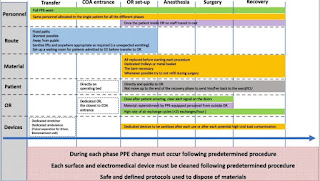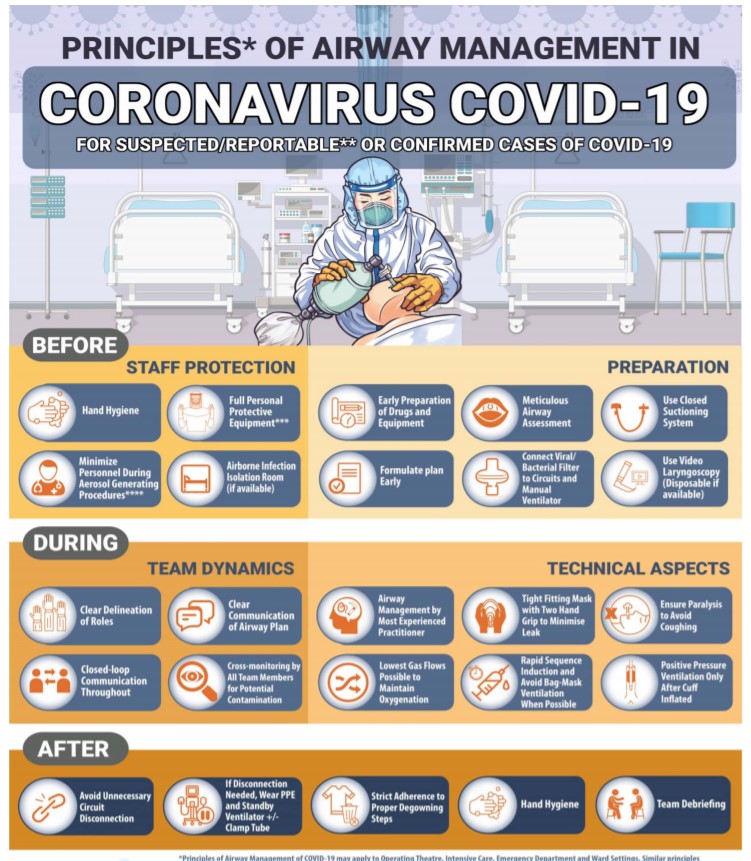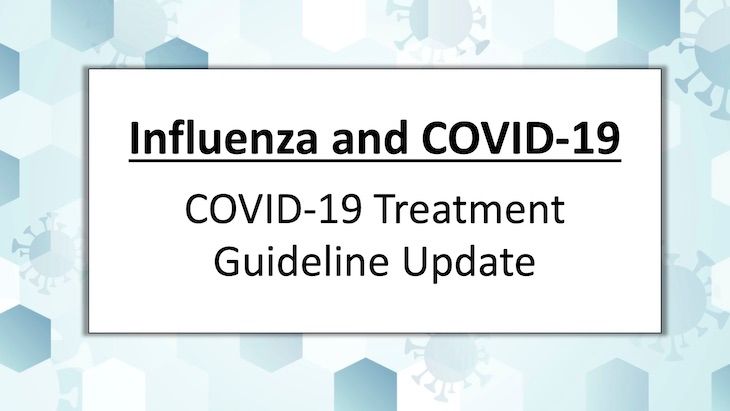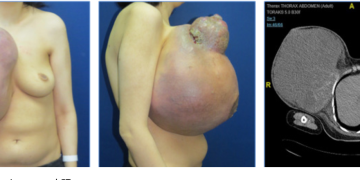The proposed outline workflow for operation theater in COVID Pandemic is detailed below. These considerations and points are proposed according to the Nepal Orthopedic Association for the COVID and Non-Covid Patient Management of the Orthopedic Patients who need surgery. These should be managed by every hospital.
Nepal Orthopaedic Association (NOA) guideline For Doctors on COVID 19 pandemic
- Zone 1: Entry dressing room, where the basic PPE is donned
- Zone 2: Anteroom, where the disinfection/scrubbing of hand and donning of surgical dress take place
- Zone 3: OR (COVID-19 room)
- Zone 4: Exit room, where the PPE is removed
- Zone 5: Exit dressing room, where the staff showers
Zone 1 and Zone 2
- When appropriate, the first act should be to place a lead garment (apron, thyroid shield).
- Then a layer of sterile protective garments can be used, the disposable surgical cap should be placed (over the hood), as well as a surgical mask with a shield. The surgical mask with a shield is an alternative to the face shield.
- After this step, the surgical hand scrubbing with an aqueous alcohol solution should be performed, and the first pair of surgical gloves should be put on.
- Finally, a sterile, disposable, reinforced surgical gown, followed by the second pair of gloves and by surgical sleeve protectors, should be put on.
- After adequate disinfection and dressing, the surgeon enters the OR (Zone 3).
Zone 3
- Here, the patient should already be under anesthesia, if intubated it should have passed at least half an hour and the surgical staff performs the surgical procedure.
- For all procedures in the OR, donning an additional pair of gloves (sterile or nonsterile depending on the type of procedure) is recommended.
- In trauma and orthopaedic surgical procedures, the use of power tools, such as electrocautery, bone saws, reamers, and drills, releases aerosols, increasing the risk of virus spread. As such, their use should be reduced to the minimum and the power settings should be as low as possible. Suction devices to remove smoke and aerosols should be used during the surgical procedures.
- At the end of the surgical procedure, and while still in the OR, the surgeon should remove the second (and third, when using) pair of gloves, the sleeve protectors,and the gown and disinfect the first pair of gloves with an alcohol solution, before removing the surgical mask with the shield and the hair cap.
- Finally, the surgeon should remove the first pair of gloves and disinfect his or her hands with an alcohol solution and exit the room.
- When exiting the OR into Zone 4, the surgeon should be wearing the same basic PPE used for entering Zone 2 (i.e., disposable scrub suit, respirator, protection glasses, and hood).
Zone 4
- As mentioned, the operative staff exits the room through a door that connects to an exit room (Zone 4) where several wastebaskets with appropriate designations should be placed, so that the PPE can be sequentially removed. PPE removal is performed in 4steps:
- the lead garment and the waterproof apron are removed and the hands are disinfected;
- the surgical hood is removed and the hands are again disinfected;
- protective glasses are removed, followed by shoe covers, and the hands are disinfected;
- finally, the FFP2 or N95 respirator is removed and the hands are again disinfected before exiting into Zone 5, where a clean changing room with showers exists.
Zone 5
- In the exit dressing room (Zone 5), the surgical staff should remove the scrub suit and bathe.
Anesthetic consideration (Discuss with your own anesthesia team before making any decision)
Pre-operative evaluation of Patient at risk of COVID 19
History
- Presence of dry cough, fever, shortness of breath
- Travel history to a high-risk area, close contact with COVID-19 patients
- Occupational exposure /Contact history
- Cluster phenomenon (Patients from the high-risk area)
Physical examination and investigation
- Check for the presence of fever
- Check blood pressure and pulse to look for the presence of shock, check SpO2 for desaturation
- Auscultate for crepitations and wheezing
- Look for leukopenia, lymphocytosis, and lymphopenia from complete blood count
- Assess organ function from liver function test and renal function test
- Look for consolidations on chest x-ray. If CT-thorax available, look for the presence of multi-lobar ground glass appearance
Prefer regional anesthesia to minimize aerosols generation procedures
General Anaesthesia:
Discuss the time interval between aerosol-generating anesthesia procedure (such as intubation) to entering the surgical team into OR. (explanation: aerosols takes some time to settle down in OR: at least 20 minutes)nepal h












Discussion about this post